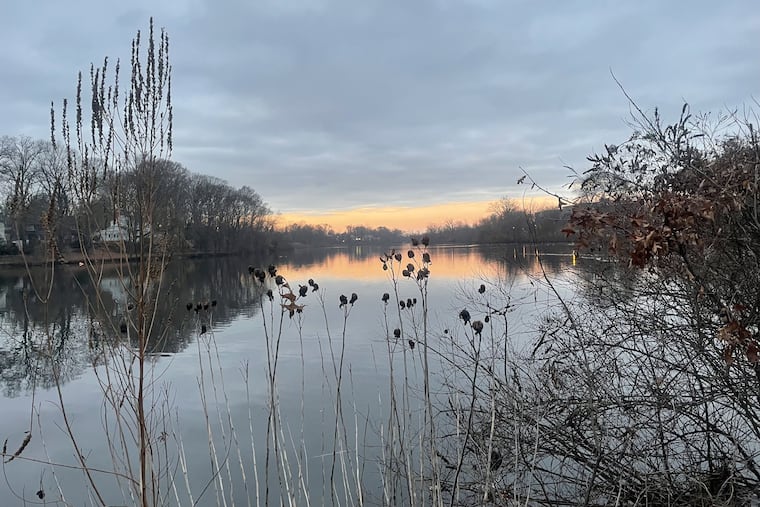After two years and $23M, Camden County’s costliest environmental project comes to a close
Newton Lake, which runs through three Camden County towns, is once again running clear, thanks to a two-year-long dredge.

Just a few years ago, Camden County’s Newton Lake was clogged by silt as it slogged through multiple towns, and its depth had dropped to two feet or less in some areas.
Spongy rhizomes of spatterdock spread through the muck below as the plant flowered in yellow above, cutting off oxygen and sunlight. Fish dwindled. Boats couldn’t cut through.
Now Newton Lake is again free-flowing through Haddon Township, Collingswood, and Oaklyn after a much-scrutinized dredge that took two years and about $23 million to complete.
In all, contractor Mobile Dredging & Video Pipe, based in Chester, lowered the depth to about five feet. Though some equipment is still removing water from remaining sludge, the dredge is effectively done. Replacement of bushes, trees, and other landscaping should be done by mid-May. The project came in slightly under the original $25 million projection.
“It is the most costly environmental project in Camden County’s history, but something had to be done,” said Jeff Nash, a longtime county commissioner who is liaison to the Parks Department. The 103-acre Newton Lake Park that encompasses the lake is part of the county park system.
Peters Creek, the tributary that forms Oaklyn’s boundary with Audubon Park, was also dredged as part of the project, as was Nichols Pond and a second pond, both in Collingswood.
In all, the county dredged about three miles of waterway.
“Our group and the neighbors are glad that the lake was dredged, and that it’s pretty much over,” said Lorraine Price, who acted as a citizen watchdog of the project through the Newton Creek Watershed Association and often pressed officials on their plans.
A pricey project
The county financed the project through a state loan program at 1% payable over 30 years. Nash said that allowed the project to proceed without having to raise taxes, and part of the loan could eventually be forgiven. By comparison, it cost about $13 million to dredge little more than a mile of the Cooper River Lake in 2017 to deepen it for rowers.
Scott Schreiber, executive director of the Camden County Municipal Utilities Authority, said 217,000 cubic yards of material was removed. About 40,000 cubic yards, or nearly 20% of the total, was contaminated with arsenic. The spoils were deposited at the long-closed Kinsley landfill in Deptford and used for capping or grading.
Schreiber said the complex dredge had to be halted during migration and nesting seasons for turtles and fish. The CCMUA was involved because of water-quality issues, as well as for access to funding.
» READ MORE: From Inquirer archives: Get ready for the Newton Lake dredging project in South Jersey
About 12 acres of spatterdock and other vegetation were removed. Some spatterdock, a member of the water lily family, was left as cover for fish.
The lake was created by damming wetlands that were a tributary of Newton Creek in the 1930s as part of a federal Works Projects Administration effort. Officials say the lake was on its way to returning to wetlands.
The lake starts in Haddon Township and is fed mostly by groundwater and storm runoff. It runs through a heavily suburban landscape starting at Cuthbert Boulevard in Haddon Township. It flows under the White Horse Pike (U.S. Route 30) and ends at the Black Horse Pike (State Route 168). The water eventually spills into the Delaware River.
An upstream problem continues
Next up, county officials say, is addressing a problem upstream that causes sediment to flow into Newton Lake. Officials say that the lake would need to be dredged again in five years if they don’t fix the problem — a major expense they want to avoid.
The sediment, county officials said, comes from runoff from nearby Haddon Township High School and an outfall at Paul VI High, as well as the developed areas around them. The runoff flows into Newton Creek across from Saddler’s Woods, a 25-acre forest containing many old-growth trees — a rarity in densely populated suburbia.
Maggie McCann Johns, the county’s parks director who oversaw the dredge project with Schreiber, said the storm water project is critical. The walls of the stream banks are 3 to 10 feet high because of erosion. County officials want to bring the water level higher and create an area of wetlands around them to absorb storm water and sediment. They say that will create a more natural flood path but will require some earth-moving and reconfiguring of the area.
McCann Johns said she and the CCMUA’s Schreiber had met with the Newton Creek Watershed Association and Saddler’s Woods Conservation Association over the plan. The state Department of Environmental Protection has been hesitant to allow a disturbance, leading the county to withdraw its permit application for now. County officials still hope to come up with a plan that’s acceptable to the state.
“Unfortunately, you’ve got to break a few eggs to do what we need to do, including removing some trees,” McCann Johns said, “so we need to get people comfortable with that and buy into it.”